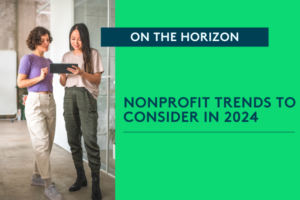Mastering Data Collection for Nonprofits: A Strategic Guide

March 31, 2025 | 6 min read
Sharing compelling data is a powerful way nonprofits can gain trust, grow supporters, and increase funding. While fundraisers should showcase important information and how their nonprofit is addressing key problems, it’s important to remember that sharing too much information can quickly overwhelm audiences. Collecting, selecting, and sharing data requires a thoughtful approach to avoid overloading audiences.
When gathering data, use the “Classify, Question, Avoid, and Share” method to determine what to collect and how to present it. This will help you gain and keep your audience’s support.
CLASSIFY: To create compelling narratives, consider classifying your data into three categories: input, output, and outcome.
- Input: This represents what you know about the situation and the scale of the challenge. For instance, if your nonprofit provides emergency shelter for communities, input data could include the number of people experiencing homelessness in the area and the resources available that address the issue.
- Output: This reflects what your organization is actively doing to create change. For example, your shelter might report the number of people who have used its services, eaten a meal, or spent the night in the facility.
- Outcome: This illustrates the tangible impact of your efforts. Highlight specific results, such as “We saved 80 lives this week by providing emergency shelter during extreme weather conditions.”
Using the input, output, and outcome criteria, you can clearly show how your nonprofit is achieving meaningful results. This will help your audience understand the full scope of your work and its importance.
QUESTIONS: When gathering data, here are seven questions to ask yourself to ensure you’re collecting and sharing the best metrics.
- Who Is My Audience? Tailor your data to the audience. Donors and the general public often respond to emotional, relatable stories, while policymakers may need more technical, in-depth data. Consider who you want to reach and the type of information they need to make an informed decision.
- What Action Do I Want? Define your objective. Are you inspiring people to donate, informing policymakers, or promoting your cause to the general public? Identifying an end goal can help shape which data to gather and share. Keep the desired action top-of-mind as you share data and ensure the call to action (e.g., donations, signatures for a petition, or volunteers) is clear, and your audience knows exactly what you’re asking them to do.
- What Resources Do I Have? If you have limited resources, every data collection effort should provide high value. Start with small, manageable metrics that tell your story and align with your goals. For example, prioritize data that highlights your impact if your goal is to secure funding.
- How Can We Grow? As more resources become available, expand data collection to include metrics that provide deeper insights. Always ask: how will this data help improve or further demonstrate our work? Don’t collect data for the sake of collecting data. Consider what you need and how it can help add further value to your work.
- Why Does this Matter to My Audience? Focus on data that connects with your audience. Explain why the numbers matter and how they tie into your mission. Showcasing your nonprofit’s impact on communities and the tangible outcomes will help audiences realize the importance of achieving your mission.
- What is the Context? Always present data in a way that’s easy for anyone to understand. Avoid assuming your audience has the same level of knowledge about the issue as you. Offer context people can relate to and connect with. For example, instead of saying one million people in the area struggle with food insecurity, consider saying, “For every five people you pass on the street, one doesn’t know where their next meal is coming from.” This puts your audience in an active position and can show how prevalent the issue is.
- Is it Actionable? Avoid collecting or sharing data unless it provides information your nonprofit can act on to strengthen your programs or outreach. If the data doesn’t support your work or your mission, reconsider your collection methods and reasoning so you can identify key data points that will help aid your work.
AVOID: Sharing the wrong information can dilute your message or even harm your credibility. Here’s what to avoid:
- Irrelevant Data: If a metric doesn’t directly support your story or goals, it’s likely not worth sharing publicly.
- Failures Without Context: Every organization faces challenges. Frame setbacks as learning opportunities that have strengthened your work or the organization.
- Assumptions: Ensure you’re providing enough context for your data. Clearly explain the situation you’re addressing and why your work matters.
SHARE: Sharing data requires a consistent, thoughtful, multi-pronged approach throughout the year:
- Platforms: There are many free or low-cost tools nonprofits can use to share their impact. Workplace-giving platforms, like Blackbaud Verified Network, social media, newsletters, and blog posts are just a few ideas where you can publish your progress. Use these platforms regularly to share impactful updates that showcase your ongoing and active efforts.
- Storytelling: Create a narrative that connects your data to real-world impact. Share vignettes that illustrate the problems you’re solving and how your work makes a difference. For example, consider the overall problem your nonprofit is addressing, then consider each tactic that addresses that problem. From there, create stories that focus on each initiative. This helps simplify your messaging and hone in on the action or initiative that’s making an impact, which can help illustrate your work to achieve your mission.
- Timely: Share updates and impact relevant to the moment. For instance, after events, share visual stories or progress updates. This shows your audience that you’re taking action and closely monitoring your programs’ impact and reach, further showcasing your nonprofit’s credibility.
- Annual Reports: Use yearly impact reports to present a comprehensive overview of your nonprofit’s achievements. This document serves as a cornerstone for transparency and accountability. Be sure to present information in a way that audiences can understand. Formatting and infographics can also help improve readability by highlighting key percentages, growth indicators, etc.
By focusing on actionable, relatable, and goal-driven data, nonprofits can maximize their impact and inspire meaningful and lasting action. Start small, think strategically, and always keep your audience’s perspective in mind. Remember, more isn’t always better.
Ready to share your impact with 8 million potential donors? Sign up for Blackbaud Verified Network today – it’s a free platform that connects you with employees with access to workplace giving programs:
Learn more about engaging key donors, tapping into workplace giving, how to get donations faster, and other free resources on our blog.
Follow The Blackbaud Giving Fund on LinkedIn, Facebook, and Instagram for updates, news, and more.


